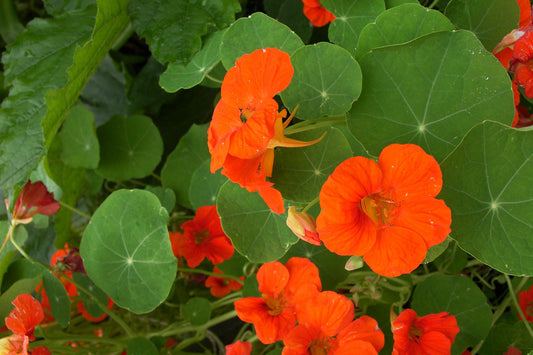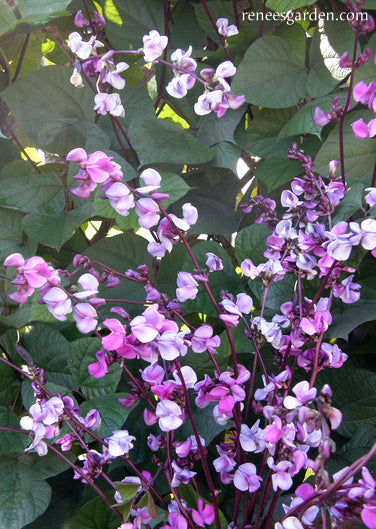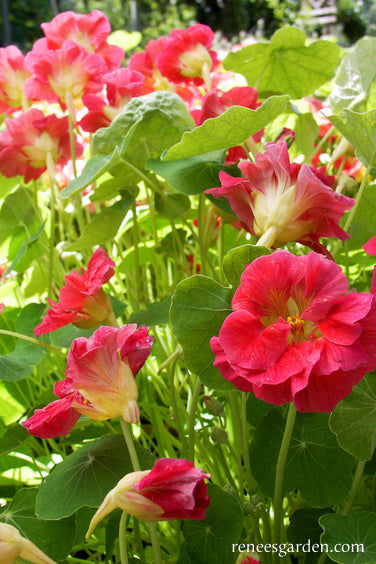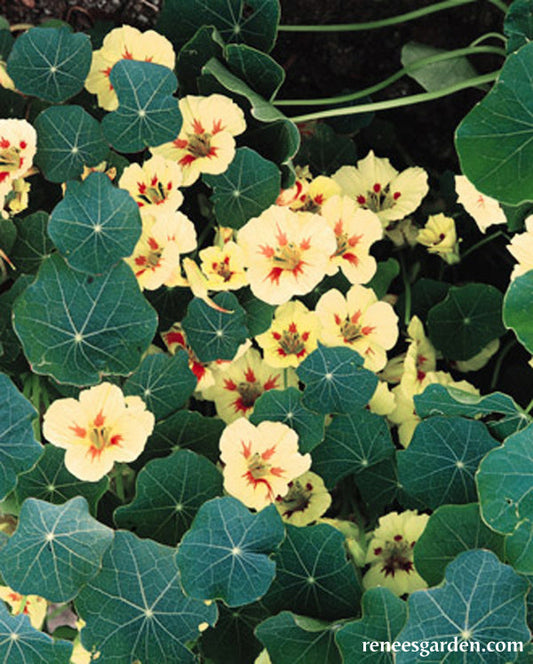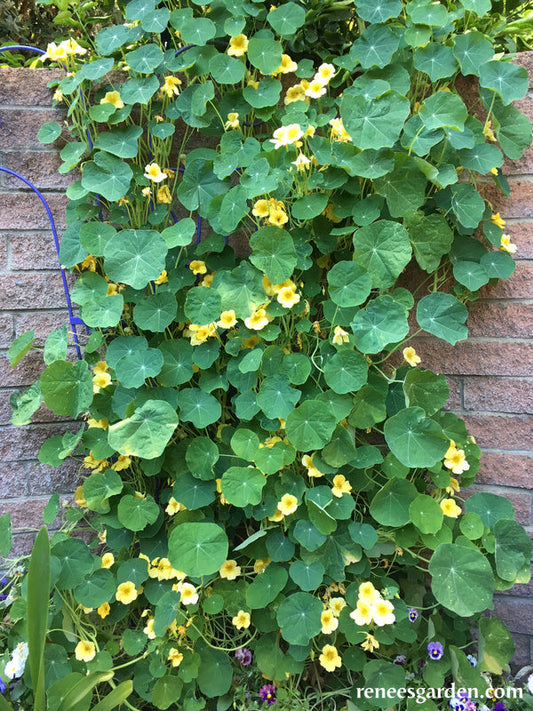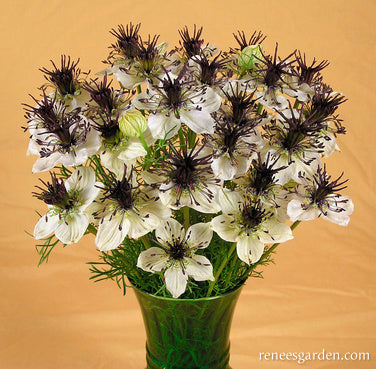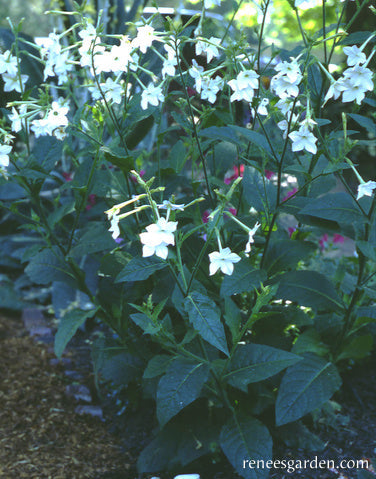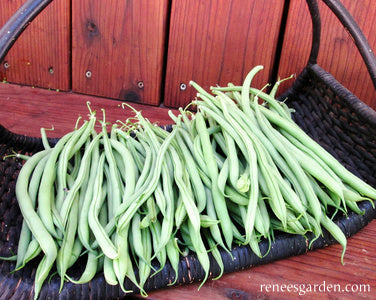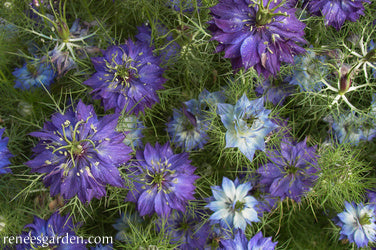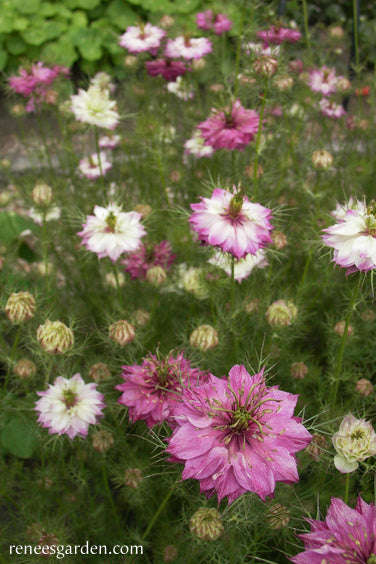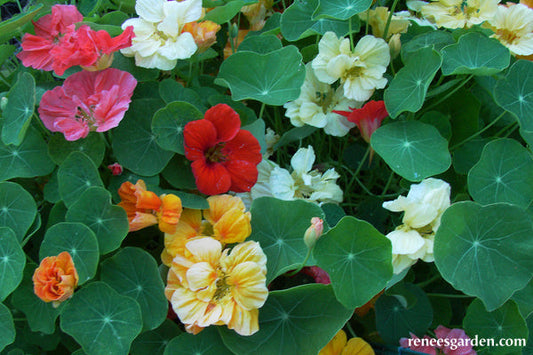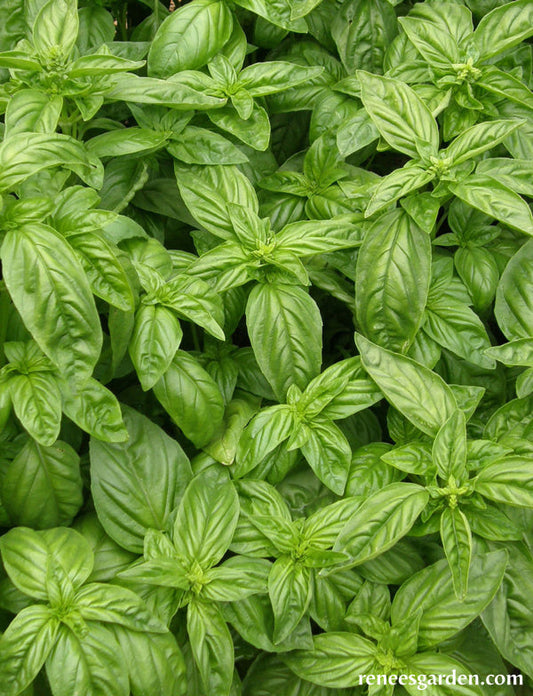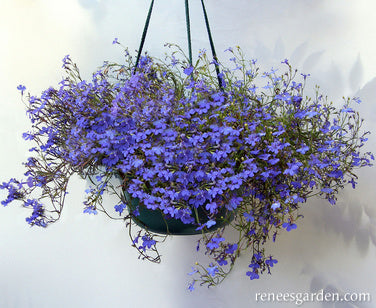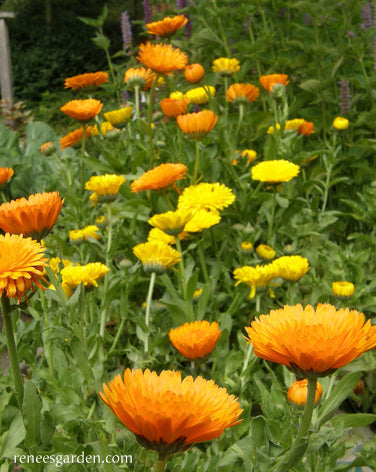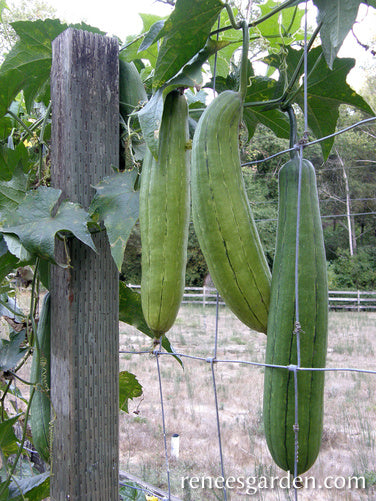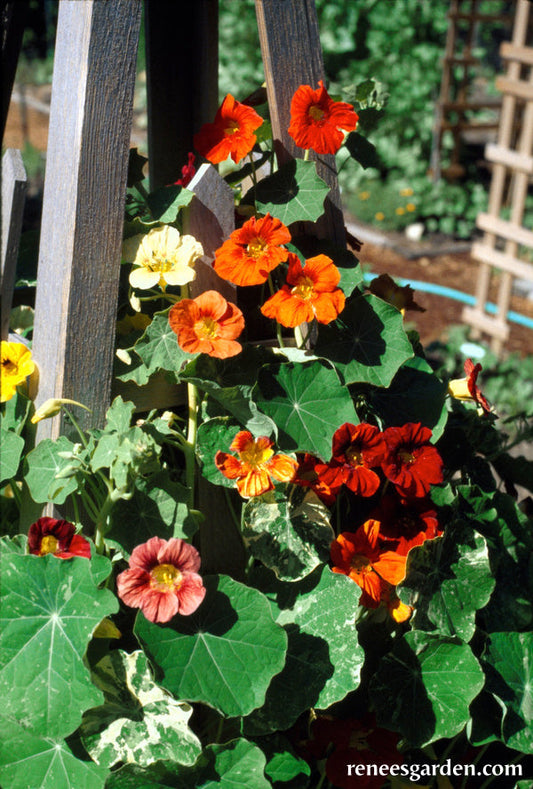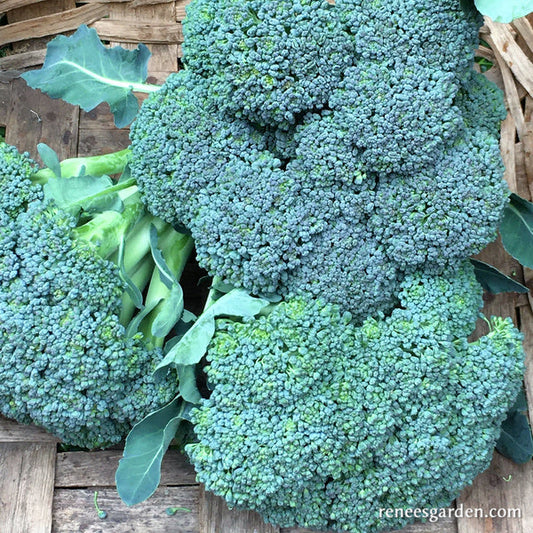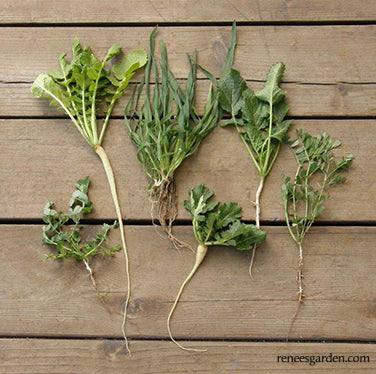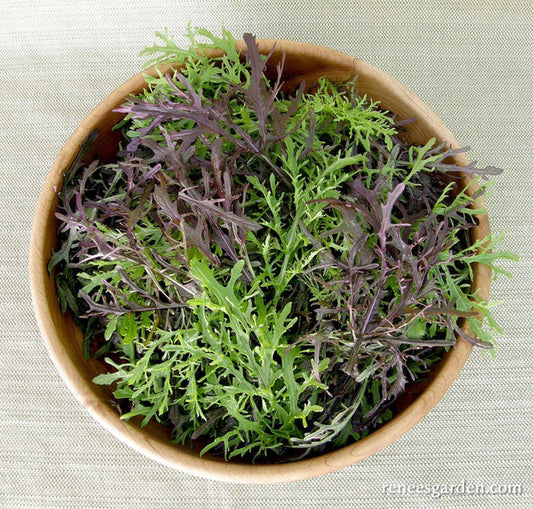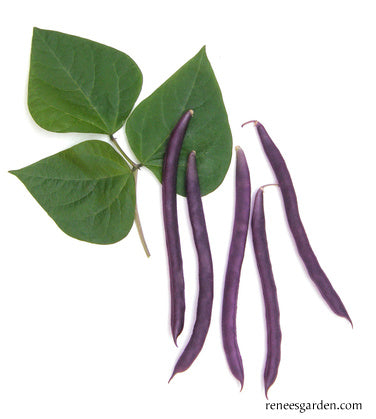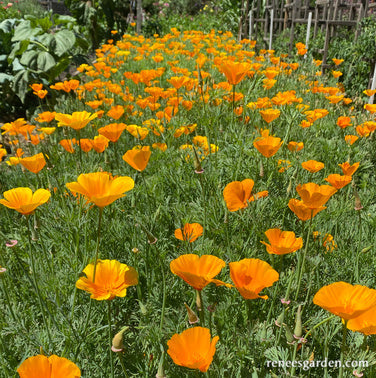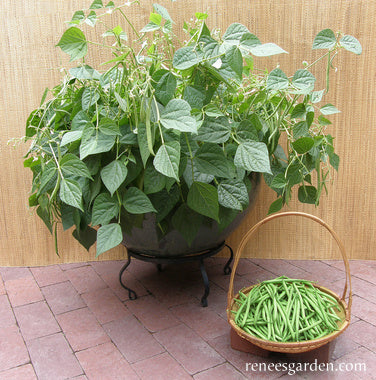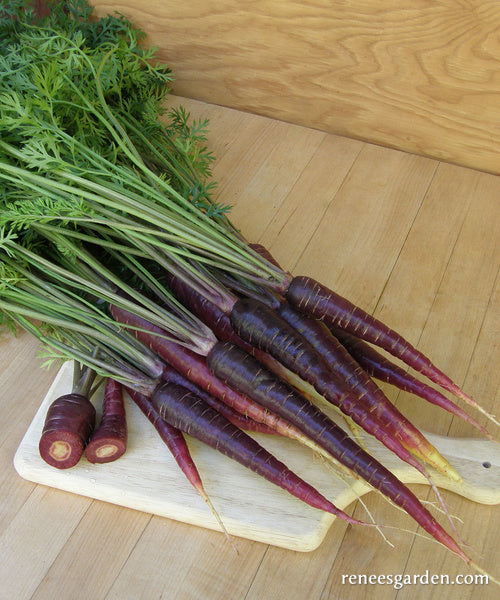All
-
Climbing Nasturtiums Spitfire
ANNUAL VINE
Spring/summer/fall bloom
Frost tenderEASY TO START OUTDOORS
Sow seeds in spring once all danger of frost is over in full sun (or part shade in hot climates). Nasturtiums need no added fertilizer in most soils. Poke seeds into well-worked soil about 1 inch deep and 3 to 4 inches apart. Press soil firmly over the seeds and keep moist. When seedlings are large enough to handle, thin 10 to 12 inches apart so plants will have ample room to grow.
TO START EARLY INDOORS
Sow 2 seeds each in individual 4-inch pots of well-drained seed starting mix 3 weeks before last expected frost date. Cover 1 inch deep. Provide a strong light source. When seedlings have several sets of leaves, pinch out the weaker seedling leaving 1 seedling per pot. When weather is evenly in the 50°F (10°C) range, gradually acclimate to outdoor conditions. Transplant 10 to 12 inches apart in full sun.
GROWING NOTES
Climbing nasturtiums are easy to grow in any well-drained soil. You’ll need to train young plants onto their supports with loose ties, then they’ll climb easily and bloom non-stop. Do not let plants dry out during blooming season. Spitfire’s glowing blossoms are summer beacons for hungry hummingbirds.
Regular price $3.39Sale price $3.39Unit price / per -
Heirloom Flowering Vine Purple Hyacinth Bean
ANNUAL VINE
Summer/fall bloom
Frost tenderTO START DIRECTLY IN THE GARDEN
In late spring once weather is warm and settled and nights stay above 50°F (10°C), plant seeds in a sunny spot in ordinary garden soil 6 inches apart and 1 inch deep. Firm soil over seeds. Keep seedlings well weeded and watered.
TO START EARLY INDOORS
Sow indoors 4 weeks before last expected frost in individual pots of seed starting mix. Cover 1 inch deep and keep warm and moist as seedlings emerge over 7 to 10 days. Provide a strong light source until seedlings are ready to plant outdoors.
Transplant very carefully once nights stay above 50°F (10°C) before plants get too crowded. Space seedlings 6 to 8 inches apart. Avoid disturbing roots as much as possible when transplanting.
GROWING NOTES
Erect heavy netting, a strong trellis or a sturdy open wood or wire fence 8 to 10 feet tall at planting time to support these warm weather climbers. Guide the first young tendrils to twine onto supports. Combine with morning glories or climbing nasturtiums for a glorious summer display of flowers and pretty pods.
Regular price $3.99Sale price $3.99Unit price / per -
Mounding Nasturtiums Cherries Jubilee
ANNUAL
Spring/summer/fall bloom
Frost tenderEASY TO START OUTDOORS
Sow seeds in spring once all danger of frost is over in full sun (or part shade in hot climates). Nasturtiums need no added fertilizer in most soils. Poke seeds into well-worked soil about 1 inch deep and 3 to 4 inches apart. Press soil firmly over the seeds and keep moist. When seedlings are large enough to handle, thin to 10 inches apart so plants will have ample room to grow.
TO START EARLY INDOORS
Sow 2 seeds each in individual 4 inch pots of well-drained seed starting mix 3 weeks before last expected frost date. Cover 1 inch deep. Provide a strong light source. When seedlings have several sets of leaves and night temperatures are above 50°F(10°C), gradually acclimate to outdoor conditions. Transplant seedlings into the garden 10 inches apart.
GROWING NOTES
These mounding nasturtiums are reliable and easy to tuck into any well-drained spot. They are a perfect disguise to cover fading bulb foliage in late spring. Their softly draping leaves and wonderfully colored flowers will quickly fill garden beds or containers. Leaves and flowers are tasty additions to salads and sandwiches.
Regular price $3.69Sale price $3.69Unit price / per -
Hummingbird Nasturtiums Vanilla Berry
ANNUAL
Spring/summer/fall bloom
Frost tenderEASY TO START OUTDOORS
Sow seeds in spring once all danger of frost is over in full sun (or part shade in hot climates). Nasturtiums need no added fertilizer in most soils. Poke seeds into well-worked soil about 1 inch deep and 3 to 4 inches apart. Press soil firmly over the seeds and keep moist. When seedlings are large enough to handle, thin to 10 inches apart as mounding plants need ample room.
TO START EARLY INDOORS
Sow 2 seeds each in individual 4-inch pots of well-drained seed starting mix 3 weeks before last expected frost date. Cover 1 inch deep. Provide a strong light source. When seedlings have several sets of leaves pinch out the weaker seedling, leaving 1 per pot. When night temps are above 50°F (10°C) gradually acclimate to outdoor conditions. Transplant seedlings into the garden 10 inches apart in full sun.
GROWING NOTES
These softly colored, intricately marked nasturtiums are reliable and easy to tuck into any well-drained spot. Except in very poor soil, nasturtiums will grow and bloom readily with no added fertilizer. The mounding plants do a fine job of covering bare spots or hiding spent bulb foliage. Use the pretty edible flowers and leaves to add zest to salads and party sandwiches.
Regular price $3.99Sale price $3.99Unit price / per -
Climbing Nasturtiums Moonlight
ANNUAL VINE
Spring/summer/fall bloom
Frost tenderEASY TO START OUTDOORS
Sow seeds in spring once all danger of frost is over in full sun (or part shade in hot climates). Nasturtiums need no added fertilizer in most soils. Poke seeds into well-worked soil about 1 inch deep and 3 to 4 inches apart. Press soil firmly over the seeds and keep moist. When seedlings are large enough to handle, thin 10 inches apart so plants will have ample room to grow.
TO START EARLY INDOORS
Sow 2 seeds each in individual 4-inch pots of well-drained seed starting mix 3 weeks before last expected frost date. Cover 1 inch deep. Provide a strong light source. When seedlings have several sets of leaves, pinch out the weaker seedling leaving 1 per pot. After outdoor temperatures are evenly above 50°F (10°C) gradually acclimate to outdoor conditions. Transplant seedlings into the garden 10 to 12 inches apart in full sun.
GROWING NOTES
Climbing nasturtiums are very reliable and easy to grow in any well-drained soil. Help them to twine up their supports, then they’ll climb easily and bloom nonstop. Do not let plants dry out during blooming season. You can also plant Moonlight to tumble along the ground.
Regular price $3.99Sale price $3.99Unit price / per -
Heirloom White Nigella Bridal Veil
HARDY ANNUAL
Spring/summer bloom
Can handle light frostEASIEST TO PLANT DIRECTLY IN THE GARDEN
Sow seeds directly into a finely textured, well-drained garden bed as early in spring as the ground can be worked. Space seeds 2 inches apart, in rows 6 inches apart. Cover seed very lightly, about 1/4 inch deep. Or broadcast seeds evenly over the seed bed and cover very lightly. Keep evenly moist while awaiting germination. Thin seedlings to stand 6 inches apart so plants have room to grow and mature. In mild winter climates, Nigella can be sown in early spring and also be sown again in cool fall weather to overwinter for spring bloom.
GROWING NOTES
Make several successive sowings from early spring through early summer and you'll have these carefree specialty flowers blooming all season long. As flowers fade, cut stems of the decorative seedpods. Hang carefully upside down in bundles out of the direct sun to easily dry for everlasting arrangements. Let some seedpods mature and stay on the plants to spill seed and these graceful flowers will come up year after year.
Regular price $3.69Sale price $3.69Unit price / per -
Heirloom Nicotiana Jasmine Alata
PERENNIAL GROWN AS ANNUAL
Summer/fall bloom
Can handle light frostTO START OUTDOORS
Sow seed directly into a finely textured, well-worked garden bed in sun or in partial shade once danger of spring frost is past. Cover very lightly and keep moist as seedlings emerge. Weed and water young seedlings carefully and thin to stand 1 1/2 to 2 feet apart before they get too crowded.
TO START EARLY INDOORS
Start seed indoors 6 to 8 weeks before last spring frost date. Sow seeds as thinly as possible in a container of seed starting mix and cover very lightly. Keep moist but not soggy, and provide a strong light source until seedlings are ready to plant outdoors after gradually acclimating to outdoor conditions. Thin or transplant seedlings 1 1/2 to 2 feet apart to allow room to grow.
GROWING NOTES
Nicotiana grows well in sun but can tolerate shade, especially during the afternoon. In mild areas, plants will winter over; cut back in fall for spring regrowth and early bloom. Plant them with other showy annuals like cosmos or cleome for an old-fashioned country garden.
Regular price $2.99Sale price $2.99Unit price / per -
Pole Filet Beans French Emerite
START SEEDS OUTDOORS
In late spring, once night temperatures stay securely above 55°F (13°C), plant seeds in well-worked, fertile soil in full sun. Erect strong stakes, tripod poles or trellis at planting time to support vines. Plant 1 inch deep and 4 inches apart along a trellis. Or grow around tripods or stakes, planting 4 to 6 seeds about 4 inches from each pole, then thinning seedlings to 3 best plants per pole.
GROWING NOTES
Beans are an easy and reliable crop, but don’t plant seeds too early; cold conditions prevent good germination. If first sowing comes up unevenly, replant right away; new seedlings will catch up quickly. Birds are attracted to young seedlings; watch carefully and protect with netting if necessary. Avoid harvesting beans in wet conditions.
HARVEST AND USE
For the best yields, pick beans frequently, at least every 2 or 3 days. Filet beans are meant to be eaten when slender, so harvest pods early, when they are still pencil-thin. These elegant gourmet beans taste best freshly picked and quickly steamed or sautéed. For a delicious salad, quickly cook the beans until just tender crisp, then combine with salad greens and Italian parsley and toss with a simple herb vinaigrette.
Regular price $4.89Sale price $4.89Unit price / per -
Heirloom Love in a Mist Persian Violet Nigella
HARDY ANNUAL
Spring/summer bloom.
Can handle light frostEASIEST TO PLANT DIRECTLY IN THE GARDEN
Sow seeds directly into a finely textured, well-drained garden bed as early in spring as the ground can be worked. In mild climates, sow in cool fall weather for spring bloom. Space seeds 2 to 3 inches apart in rows 6 inches apart and cover 1/4 inch deep. Or broadcast thinly in garden bed and cover 1/4 inch deep. Weed young seedlings carefully and thin to stand 6 inches apart so plants have room to grow and mature.
GROWING NOTES
Make several successive sowings from early spring through early summer and these carefree old-fashioned flowers will bloom all season long. Their delicate blossoms make sweet little bouquets. As flowers fade, cut the decorative seedpods before they mature and split. Hang upside down in bundles out of the direct sun to dry for winter bouquets and arrangements. Let some seedpods mature on the plants to spill seed and these graceful flowers will come up year after year.
Regular price $3.39Sale price $3.39Unit price / per -
Love in a Mist Mulberry Rose Nigella
HARDY ANNUAL
Spring/summer bloom
Can handle light frostEASIEST TO PLANT DIRECTLY IN THE GARDEN
Sow seeds directly into a finely textured, well-drained garden bed as early in spring as the ground can be worked. In mild climates, sow in cool fall weather for spring bloom. Space seeds 2 to 3 inches apart in rows 6 inches apart and cover 1/4 inch deep. Or broadcast thinly in a garden bed and cover 1/4 inch deep. Weed young seedlings carefully and thin before they get too crowded. Thin or transplant seedlings 4 to 5 inches apart.
GROWING NOTES
Make several successive sowings in early spring to enjoy these carefree old-fashioned flowers throughout spring and early summer. Their delicate blossoms make sweet little bouquets. As flowers fade, cut the decorative seed pods before they mature and split. Hang upside down in bundles out of direct sun to dry for winter bouquets and arrangements. Let some seedpods mature on the plants to spill seed and these graceful flowers will come up year after year.
Regular price $3.39Sale price $3.39Unit price / per -
Rainbow Nasturtiums Whirlybird Mix
ANNUAL
Spring/summer/fall bloom
Frost tenderEASY TO START OUTDOORS
Sow seeds in spring once all danger of frost is over in full sun (or part shade in hot climates). Nasturtiums need no added fertilizer in most soils. Poke seeds into well-worked soil about 1 inch deep and 3 to 4 inches apart. Press soil firmly over the seeds and keep moist. When seedlings are large enough to handle, thin to 10 inches apart as mounding plants need ample room to grow.
TO START EARLY INDOORS
Sow 2 seeds each in individual 4-inch pots of well-drained seed starting mix 3 weeks before last expected frost date. Cover 1 inch deep. Provide a strong light source. When seedlings have several sets of leaves, pinch out the weaker seedling, leaving 1 per pot. When night temps are above 50°F (10°C) gradually acclimate to outdoor conditions. Transplant seedlings into the garden 10 inches apart in full sun.
GROWING NOTES
These mounding nasturtiums are reliable and easy to tuck into any well-drained spot. They are a perfect disguise to cover fading bulb foliage in late spring. Their softly draping leaves and wonderfully colored flowers will quickly fill garden beds or containers. Nasturtium leaves and edible flowers add zest to salads and sandwiches.
Regular price $3.99Sale price $3.99Unit price / per -
Bolognese Basil Aurelia
ANNUAL
Summer/fall harvest
Heat-loving, frost tenderTO PLANT DIRECTLY INTO THE GARDEN
When late spring weather reaches 55°F (10°C) both day and night, sow seeds 1 inch apart in well worked, fertile soil in full sun. Cover 1/4 inch deep, firm soil and keep seed bed moist. Germination takes 1 to 2 weeks. After seedlings are well established, thin or transplant 8 inches apart, which allows plants enough elbow room grow and mature.
TO START EARLY INDOORS
Sow seeds 1 to 2 inches apart in a container of fresh seed starting mix, 4 weeks before last expected frost. Keep warm and evenly moist, and provide a good light source. Feed with 1/2 strength liquid fertilizer every 10 days. Once weather warms outdoors, acclimate seedlings to outdoor conditions, then transplant 8 inches apart into the garden.
GROWING NOTES
It is critical to sow seed or transplant basil seedlings only when late spring day and nighttime temperatures stay above 55°F (13°C). Harvest sprays of leaves by snipping stems just above two new sprouting lateral branches to encourage lush foliage. Keep flower buds pinched off to extend harvesting. Feed regularly with high nitrogen fertilizer after harvesting to promote new growth. Except in very short season areas, make a second planting three weeks after the first for a continued supply of fresh, aromatic leaves.
Regular price $3.69Sale price $3.69Unit price / per -
Windowbox Lobelia Blue Heaven
ANNUAL
Spring/summer/fall bloom
Frost tenderBEST TO START SEEDS EARLY INDOORS
In early spring, about 6 weeks before last spring frost, sow these tiny seeds thinly in a container of seed starting mix, but do not cover seeds, just press lightly into the soil and gently mist to keep moist until germination. Keep evenly moist and about 65-75°F (18-24°C). Provide a strong light source. When seedlings are large enough to handle and night temps reach 50°F (10°C), gradually acclimate to outdoor conditions. Transplant in little clumps of 4 to 5 seedlings about 5 inches apart in well-drained soil in sun or part shade.
Container Growing: Transplant seedlings into pots or baskets that are at least 10 to 12 inches across and 10 to 12 inches tall. Fill with moistened fresh potting mix, then transplant small clumps of 4 to 5 seedlings several inches apart and water gently. Be sure to keep Lobelia in containers well watered and feed with all-purpose fertilizer every few weeks for continual profuse bloom. Shear spent flowers back for reblooming.
GROWING NOTES
Whether used as a gorgeous groundcover color accent or for a trailing window box or patio container display, this lovely Lobelia will bloom longest if it has rich, moist soil, so don’t forget to water regularly as needed and fertilize frequently.
Regular price $3.39Sale price $3.39Unit price / per -
Butterfly Calendula Mix Orange & Lemon Twist
HARDY ANNUAL
Spring/fall bloom
Takes light frostTO START OUTDOORS
Calendulas bloom best in cool weather, so plant in early spring in well-drained soil after danger of frost is over. Sow seeds 1 in. apart, cover 1/2 in. deep, firm soil and keep seed bed moist while awaiting germination in 7 to 14 days. After seedlings are well established, thin or transplant 8 in. apart.
Container growing: plants also grow and bloom well in pots at least 12 to 16 in. deep and 18 to 20 in. across. Start with fresh potting mix each season, keep well watered and fertilize monthly.
TO START EARLY INDOORS
In early spring, sow seeds 1 in. apart in a container of seed starting mix and cover ½ in. deep. Keep evenly moist as seedlings emerge and provide a good light source until ready to plant outdoors. Transplant when seedlings are about 2 to 3 in. tall after gradually acclimating plants to outdoor conditions.
GROWING NOTES
Thin seedlings to proper spacing for good air circulation and to discourage mildew. Keep faded flowers removed. Lemon & Orange Twist are easy to grow spring annuals, producing sturdy plants soon covered with bright flowers that bloom nonstop and attract butterflies for many weeks. In mild climates: sow again in late summer for winter or early spring flowers.
Regular price $3.39Sale price $3.39Unit price / per -
Compact Vining Gourds Bath Loofah
BEST TO START INDOORS
Several weeks before last spring frost, sow seeds 1 in. deep in individual pots of seed starting mix. Keep warm and moist and provide a strong light source. When seedlings are well established and nights stay above 55°F (13°C), acclimate to outdoors. Transplant at sunny garden edges to ramble, or 12 inches apart along a sturdy fence or trellis to climb and form a lush canopy.
START SEEDS OUTDOORS
Start seeds outdoors only after night temps stay above 55°F (13°C). In full sun, sow 2 or 3 seeds 1 inch deep in groups spaced 12 inches apart and 4 inches from vertical supports. Thin to 1 or 2 strongest seedlings per group.
GROWING NOTES
Loofahs need full sun, very rich, fertile soil and warm temperatures. For earliest and best yields, hand-pollinate gourds: pick a blooming male flower and dust pollen onto fresh female flowers (the ones with small fruits at the base). Repeat as new flowers appear. Pollinated fruits start growing larger within several days.
HARVEST AND USE
Harvest when loofahs are fully matured with brown and dry outer rinds, are very light for their size, and seeds rattle inside. Peel off the dark outer rind, exposing the fibrous honeycomb sponge-like interior. Cut open end to shake out seeds. Finish by soaking loofahs for an hour in a weak bleach solution (10:1) to whiten and brighten color. Rinse thoroughly and air dry. Use in everyday skincare as a natural sponge, skin, buffer and exfoliator.
Regular price $4.39Sale price $4.39Unit price / per -
Climbing Nasturtiums Amazon Jewel
ANNUAL
Spring/summer/fall bloom
Frost tenderEASY TO START OUTDOORS
Sow seeds in spring once all danger of frost is over in full sun (or part shade in hot climates). Nasturtiums need no added fertilizer in most soils. Poke seeds into well-worked soil about 1 inch deep and 3 to 4 inches apart. Press soil firmly over the seeds and keep moist. When seedlings are large enough to handle, thin 10 inches apart so plants will have ample room to grow.
TO START EARLY INDOORS
Sow 2 seeds each in individual 4 inch pots of well-drained seed starting mix 3 weeks before last expected frost date. Cover 1 inch deep. Provide a strong light source. When seedlings have several sets of leaves, pinch out the weaker seedling leaving 1 seedling per pot. When weather is evenly in the 50° F (10° C) range, gradually acclimate to outdoor conditions. Transplant seedlings into the garden 10 to 12 inches apart in full sun.
GROWING NOTES
Climbing nasturtiums are very reliable and easy to grow in any well-drained soil. Help them to twine up their supports, then they’ll climb easily and bloom non-stop. Do not let plants dry out during blooming season. You can also plant Amazon Jewel to tumble along the ground.
Regular price $3.39Sale price $3.39Unit price / per -
Early Heading Broccoli Batavia
BEST TO START INDOORS
Start seeds 4 or 5 weeks before last expected spring frost and again in midsummer for a fall crop. Sow seeds 1 inch apart in a container of seed starting mix, cover 1/2 inch deep and keep evenly moist. Provide a strong light source until seedlings are ready to plant out. When seedlings are 3 to 4 inches tall, gradually acclimate to outdoor conditions, then transplant 12 to 18 inches apart into rich, well-drained soil in full sun.
TO START OUTDOORS
Sow seeds in well-worked, fertile soil in full sun. Plant groups of 2 to 3 seeds 1/2 inch deep and 12 inches apart. Space rows 18 inches apart. Thin to 1 strong seedling per group so plants have room to mature and grow.
GROWING NOTES
Broccoli needs rich, fertile soil and cool growing weather to produce big heads. Prepare soil well and do not let seedlings get too crowded before thinning or transplanting or the heads will be stunted. Keep well watered and weeded. Feed at least monthly with all purpose fertilizer. Use nontoxic B.T. (Bacillus thuringiensis) products to repel caterpillar pests as necessary.
HARVEST AND USE
Harvest the main head before florets open by cutting about halfway down the stalk. This will encourage numerous side shoots to form for extended picking from each plant.
Regular price $4.89Sale price $4.89Unit price / per -
Protect & Fertilize Green Cover Crop Blend
The Renee’s Garden Cover Crop Mix is a blend of several legumes, grass, roots, and rapeseed. The legumes, Austrian Winter Peas, Fava beans and Hairy Vetch all fix nitrogen from air into their root nodules, loosen and aerate dense soil and gather deep nutrients and minerals. Winter Rye Grass has thick roots which hold the soil to prevent erosion and takes up excess nutrients in the soil. Rapeseed takes up large amounts of nutrients that would otherwise be leached out of the soil by the winter rains. When these cover crop plants are incorporated back into the soil in the spring, they break down releasing the nutrients and minerals back into the soil and add plenty of organic matter which improves the soil structure.
NOTE
Seed is packed with a larger quantity of organic rice hulls to help space seeds. Before opening, shake can thoroughly to mix together.
FORMULA MIX
Winter Rye, Hairy Vetch, Fava Bean, Rapeseed and Austrian Winter Peas.
Inert material: organic rice hulls.
WHEN TO PLANT
In Mild Winter Climates, where ground does not freeze hard, sow in late fall to over-winter for spring growth.
In Cold Winter Climates, where ground freezes hard, plant in fall for winter die back and then incorporate in spring, OR sow as early as possible in spring..
HOW TO PLANT AND GROW
Remove all weeds, grass and large stones from the planting area and break up soil clumps. Evenly loosen the top 2 inches of soil with a rake. Shake the can thoroughly before opening, then scatter contents evenly over the prepared ground, aiming for scattering the seeds 1 to 2 inches apart. Use a rake to cover the seed mixture with fine soil 1/4 to 1/2 inch deep. Lightly firm soil with the back of the rake and water thoroughly. Keep soil bed evenly moist while awaiting germination and while seedlings are small. Plants will grow and thrive best if watered regularly.
INCORPORATING YOUR COVER CROP
Method 1: When 5 to 6 inches tall, use a garden fork, shovel or rototiller to turn the cover crop into the ground to break down and enrich soil for planting. The breakdown process takes about a month.
Method 2: When cover crop is 1 foot tall, pull out the plants, shake off soil and then compost the plant material to incorporate it into the soil later, when it has turned into rich, finished compost. Timing depends how long your composting process takes.
Method 3: When cover crop reaches 1 to 1-1/2 feet tall, weed whack to chop it down. Cover the chopped material with black plastic to hasten decomposition, then turn the nutritious residue into the soil 2 to 3 weeks before sowing your garden crops.
Regular price $16.95Sale price $16.95Unit price / per -
Cookbooks The Renee's Garden Cookbook
Sample Recipe
• Kale With Peanut Lime Dressing • Tomato And Red Lentil Soup With Dried Apricots And Lime
Sample Pages
• Carrots • Chard • Salads With Lettuce
Recipes include Renee’s favorites such as:
• Ginger Pumpkin Flan
• Tomato and Red Lentil Soup with Dried Apricots and Lime
• Italian Escarole Soup with Tiny Turkey Meatballs
• Grandma’s Kosher Dill Pickles
• Chunky Chicken Salad with Apples
• Dried Cranberries and Toasted Nuts
• Gingery Gingersnaps
• Green Bean Salad with Lime and Mustard Dressing
• Mary Jo’s Albacore Tuna with Fresh Sage and Bow-Tie Noodles
• Grilled Champagne Onions with Sage
• Baked Cauliflower with Ricotta and Chives
• Orzo with Arugula and Mushrooms
• Ginger-Glazed Roasted Root Vegetables
• Pam's Fresh Pea Soup
• Lavender Jelly
Reviews
"Garden to table took on new meaning when Renee Shepherd and Fran Raboff put their talents together to create this cookbook. Growing vegetables from seed tested in Shepherd’s trial gardens yield a variety of prospects each season in flavor, colors and textures. Every vegetable highlighted includes description, growing tips, uses and storage. Several recipes are offered for each vegetable in both vegetarian dishes and meat dishes. Each entry also includes growing fax and pointers. Herbs are also covered in this cookbook as well as edible flowers. All recipes are beautifully illustrated by Mimi Osborne, the same artist that provides the gorgeous watercolor depictions of each new variety for Renee’s Garden website. THE RENEE’S GARDEN COOKBOOK is a book you will refer to time and time again for delicious meal ideas as well as expert gardening advice." - Cindy K.
"As you harvest late summer veggies from the garden, you may be running low on ideas for using yet another squash, pepper or tomato. Take a look at The Renee’s Garden Cookbook and you’re likely to find yourself wishing for even more produce. Authored by longtime garden seed entrepreneur and garden guru Renee Shepherd with cooking instructor and author Fran Raboff, the 156-page cookbook is chock full of recipes designed to make the most of homegrown veggies." - Parade magazine
"As gardeners, we are all blessed with an abundance of fresh, delicious produce that is a joy to prepare and savor. But if you're like me, I sometimes get into a rut with the way I prepare certain vegetables. This cookbook gives me the opportunity to expand my repertoire in a delicious way. The cookbook is organized in two ways, making it easy to come up with recipes for seasonal veggies and herbs. First, the main section is divided into all of the types of vegetables you can think of: artichokes, beans, beets, and broccoli, for example. There is also an herb section that includes recipes using savory or sweet herbs. Second, the extensive index not only covers all of the vegetables or herbs in the book but it also includes other ingredients found within the recipes. That makes it easy to either select a recipe based on the products you have available or on what you have in your refrigerator or pantry, such as chicken or pasta. Won't that make meal-planning a breeze!" - Susan M.Regular price $17.95Sale price $17.95Unit price / per -
Colorful Salad Mustards Ruby & Emerald Streaks
START SEEDS OUTDOORS
In cool early spring weather, sow seeds in finely-worked soil in full sun. Shake seeds from the palm of your hand, broadcasting them about 1/2 inch apart over the entire seedbed or in wide rows, and cover lightly and evenly with 1/4 inch of fine soil. Firm soil gently and water with a fine spray. Keep seedbed evenly moist. Make small successive sowings until summer weather turns hot for a constant supply. Plant again in late summer for fall harvesting.
GROWING NOTES
These feathery, lacy plants grow easily in cool weather with consistent moisture and will produce a fast leafy harvest. To extend the sowing season into hot weather, sow in light shade or erect a canopy of loosely woven shade cloth over the bed. Birds are often attracted to tender young seedlings, so protect them if necessary.
HARVEST AND USE
To harvest by the “cut and come again” method, wait until plants are 4 to 6 inches tall. Cut as much as you need, using scissors to shear off a patch of leaves about 1 to 2 inches above the soil level. Water well and fertilize lightly and plants will regrow for more cuttings before summer heat comes on. Enjoy Ruby Red and Emerald Green’s beautiful colors and delicious, mildly spicy mustard flavor in spring and fall salads, on cheese plates and add the pretty, savory leaves to sandwiches and Panini.
Regular price $4.89Sale price $4.89Unit price / per -
Heirloom Pole Beans Rich Purple Pod
START SEEDS OUTDOORS
In spring, once weather is warm and settled and nights stay securely above 55°F (13°C), plant seeds in well-worked, fertile soil in full sun. Poke seeds in 1 inch deep and 4 inches apart in rows 1½ to 2 feet apart. Make additional sowings several weeks apart until the end of June to provide long continued harvests.
GROWING NOTES
Tender crispy garden beans are an easy and reliable crop to grow, but don't plant seeds too early as cold conditions prevent good germination. If first sowing comes up unevenly, replant right away; new seedlings will catch up quickly. Birds are often attracted to young bean seedlings, so watch carefully and protect with netting or floating row covers if necessary. Avoid cultivating plants or picking pods when plants are wet.
HARVEST AND USE
These vigorous plants produce strong harvests. The more you pick, the more the plants will produce, and the nitrogen fixing bacteria on the roots of bean plants actually improves your soil. Sow another crop about three weeks after your first planting and you’ll have a welcome second harvest in late summer. Tasty Royalty Purple Pod bean pods will turn green after a few minutes of cooking.
Regular price $4.89Sale price $4.89Unit price / per -
California Native Orange Poppies
NOTE
The Poppy seeds in this can are packed with a larger quantity of milled rice hulls to help space the tiny seeds when scattering.
Before opening, shake the can thoroughly to mix them together so when you cast the seeds they are spaced with room for the plants to grow.
HOW TO PLANT
In mild winter climates, where the ground does not freeze hard, poppies can be sown in late fall to overwinter for spring bloom. Or, plant as early as possible in spring, as poppies can handle light frosts and bloom longest when given a good start in cool weather.
To prepare the planting area: remove all weeds, grass and large stones. Break up soil clumps and evenly loosen the top 2 inches of soil with a digging fork or shovel, then smooth out with a flat rake.
Shake the can thoroughly before opening, then scatter the contents thinly and evenly over the prepared ground. Using your rake, cover the seed mixture 1/4 inch deep and lightly firm the soil. Water with a gentle mist thoroughly and evenly. Keep the soil moist while awaiting germination and while the seedlings are small.
GROWING NOTES
Mature poppy plants can handle dry conditions, but will thrive and bloom much longer if watered regularly. Poppies make lovely cut flowers if brought indoors just as the buds begin to open. At season’s end, let spent flowers form pods and drop seeds to bloom again the next spring.
Regular price $16.95Sale price $16.95Unit price / per -
Container Bush Beans French Mascotte
START SEEDS OUTDOORS
In spring, once weather is warm and settled and night temperatures stay above 55°F (13°C), plant seeds in well-worked, fertile soil in full sun. Poke seeds in 1 inch deep and 4 inches apart in rows 1½ feet apart.
FOR CONTAINER PLANTING
Sow seeds in big pots at least 18 to 20 inches in diameter and 18 inches tall filled with fresh, moistened, good-quality potting mix. Make additional sowings in more pots several weeks later until the end of June to provide long continued harvests.
GROWING NOTES
Amend soil well before sowing with lots of aged manure or compost. Protect young seedlings from marauding birds by covering with plastic berry baskets at planting time, removing when plants get crowded. Be sure to thin properly—you will have more productive, disease-free plants if seedlings have enough room to mature.
HARVEST AND USE
Pick these fine-flavored French gourmet beans often; at least every other day or while bean pods are young and slender. The more beans you pick, the more the plants will produce. Steam, sauté or roast them quickly just until tender-crisp and serve simply to fully enjoy their tempting flavor.
Regular price $4.99Sale price $4.99Unit price / per -
Rainbow Carrots Purple Sun
START SEEDS OUTDOORS
In spring once danger of hard frost is past, sow seeds in full sun in finely worked, fertile soil. Sow 1/4 inch deep and 1/2 inch apart in rows 8 inches apart, or broadcast thinly in beds and cover lightly.
Keep seedbed evenly moist as carrots can be slow to germinate, emerging over 10 to 20 days. If first sowing comes up unevenly, replant right away as seedlings catch up quickly. Be sure to thin young carrots several times so seedlings are about 2 inches apart and have the room they need to size up.
GROWING NOTES
Carrots like well-worked soil and need consistent moisture to grow well. If your soil tends to dry out, cover seedbed with floating row cover to help retain moisture during the germination period and water right through it. Keep carrots well watered and thinned. For a late season crop, sow again 3 months before first expected frost.
HARVEST AND USE
For best flavor, let Purple Sun carrots size up and color up fully before harvesting. Enjoy these beautiful, extra healthy carrots raw as snacks or grated into salads for great eye appeal. Sauté or steam just until tender crisp and serve with a little sweet butter and your favorite fresh chopped herb. Carrots go well with dill, tarragon, chives, cilantro or mint.
Regular price $4.69Sale price $4.69Unit price / per

